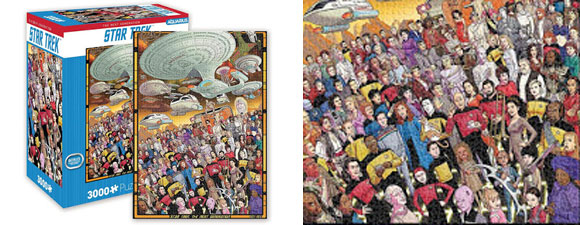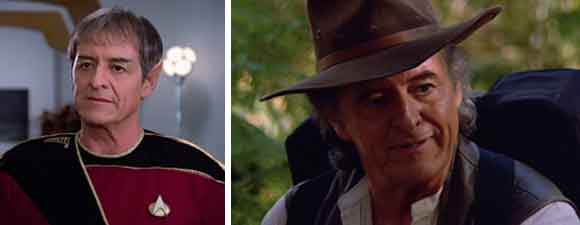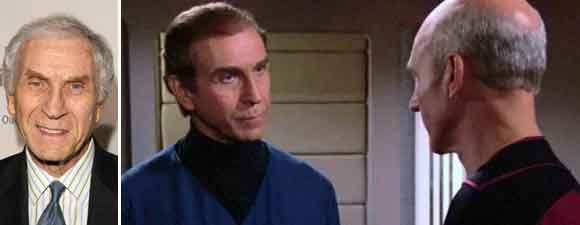Retro Review: Time’s Arrow, Part Two
6 min readWhile Data is reunited with Guinan in 19th century San Francisco, the Enterprise bridge crew tries to stop aliens from interfering with Earth’s past.
Plot Summary: The Enterprise bridge crew begins its investigations in 19th century San Francisco, seeking both Data and the disguised Devidians who have apparently been pursuing human plague victims. When visiting the hospital and morgue with Riker, who is disguised as a policeman, Crusher pretends to be a nurse and is able to determine that the deaths were not caused by cholera, but by the Devidians draining the neural energy of human victims. She confronts the male “doctor” and takes his walking stick, which is not really a snake-headed cane but a disguised Ophidian which the Devidians are using to harness triolic waves and manipulate the temporal portals that allow them to travel between their own planet and Earth. A suspicious policeman tries to have the Enterprise crewmembers arrested but they are able to flee when Data arrives in a horse-drawn carriage. Data, meanwhile, has been working with Guinan to evade Samuel Clemens, who believes they have both come from outer space to destroy humanity. Clemens follows the Enterprise crew to the cavern where Data’s head appeared centuries later and confronts them, but before Picard can explain their full intentions, the Devidians arrive to recover the Ophidian and return to their own planet. They struggle with Data, whose head is blasted off in an explosion that also injures Guinan. The male Devidian leaps through the portal opened by the Ophidian, followed by Riker, LaForge, and the others, including the curious Clemens. Picard pauses to help Guinan and is trapped when the portal closes along with Data’s head. Back on the Enterprise, Troi is able to assure Clemens that they are there to protect humanity’s future and LaForge is able to attach the head discovered by the archaeologists to Data’s body. Worf convinces Riker to destroy the site from which the Devidians have been transporting to Earth, but just as he is about to do so, Data accesses a message manually programmed by Picard in the 19th century telling them to wait. Clemens volunteers to go back to his own century so that Picard can be rescued and warn the Enterprise that they must adjust their torpedoes for the temporal flux before attacking the Devidian base. He leaves the Guinan of the 19th century safe with Clemens and returns to visit the one on the Enterprise, who has remembered everything since they met five centuries earlier.
Analysis: Since both Christmas and New Year’s Day fell on Fridays, I pretended the winter holidays were the break between seasons five and six, and didn’t watch part two for two weeks after part one of this episode. I had remembered feeling that the conclusion to “Time’s Arrow” had felt like a big let-down and wanted to see whether that situation repeated itself. I must confess that it did; while “Time’s Arrow, Part Two” has some lovely elements, including the fine acting it’s easy to take for granted, costumes and hair design that won Emmy Awards, and special effects that are a definite improvement over the first part of the story, it doesn’t hold up next to Next Gen‘s best, which includes the previous two season finale/premieres, “The Best of Both Worlds” and “Redemption,” plus the recent two-parter “Unification.”
As odious as comparisons may be, it’s easiest to explain one of my disappointments with a glance at an episode from another franchise altogether. When Doctor Who meets Shakespeare, they speak as equals, not only because of the Doctor’s enormous respect for the literary giant but also because Shakespeare (who’s hardly a paragon of virtue in the episode, drinking and flirting with everyone in sight) doesn’t need a lecture by the Doctor on Earth history or human nature. For everything he’s seen in the universe, the Doctor isn’t any more expert on emotion or behavior than the arguably the greatest writer this planet has ever produced. Mark Twain isn’t Shakespeare, but he’s also an unquestioned giant, someone whose insight into the people who shared his world remains widely appreciated and quoted not only in the country where he lived. One would think that the father of American literature would have a bit to teach Picard and his crew, not that he’d need a lecture from Troi about how much nicer people would be if only poverty were eradicated. In fact, I expected a bit of debate from the humorist and sometime cynic – like Shakespeare, Twain lost a child, which sent him into a deep depression and affected his subsequent view of the human condition. The Samuel Clemens we meet in “Time’s Arrow,” like the young, cliche-spouting Jack London, is a caricature rather than a character.
If the science fiction story or the crew character development were spectacular, that wouldn’t matter – Twain is mostly used for comic relief at first, and later as a plot device to get Picard back onto the ship. But the storyline overall just isn’t that enthralling. Sure, it’s exciting to see 19th century San Francisco through the eyes of the Enterprise crew, and there are plenty of funny moments – Riker trying to convince a fellow policeman that he isn’t a fraud, Picard auditioning his landlady to appear in A Midsummer Night’s Dream in order to stall on paying the rent – and I’m always happy to see Troi struggling with a corset while Data struts around in a suit. Underneath the clothes, though, it’s a plot about evil aliens using a cholera epidemic to cover their tracks so they can steal human neural energy for their people to ingest…does that sound as silly to other people as it does to me? These aliens time-travel using some weird form of energy harnessed by a big snake disguised as a walking stick! Which Crusher is able to wrest away from the evil alien in thirty seconds! It’s definitely not the writers’ finest moment.
The first part of “Time’s Arrow” gained pathos because so much of it was about the feelings of Data and his friends upon learning not only that he will someday die, but that his head will be discovered in Earth’s past, little changed in appearance though presumably inert. However, all interest in the existential dilemma vanishes once Data’s head is actually blown off – LaForge sticks it back on his body and gets it working seemingly within the hour, with the only hitch being that Picard input the manual data that will protect Earth and himself as well. I guess now we know the answer to the question of whether Data will ever rust. But the question of whether he will die remains up in the air, since he is reactivated seemingly with no negative effects from his head having been lost under San Francisco for half a millenium. In theory this means that he could be reactivated by some more advanced species who find only some of his parts, many thousands of years in the future when not only the people he has known but even the civilizations he has known may have vanished.
There’s nothing terrible about this episode; as I said in my review of the first part, it isn’t as if Evil Alien Nazis show up and make the whole thing laughable. And there are some elements I really like – the backstory to Picard’s little-explored relationship with Guinan, which is described by both of them as passionate and intense yet very rarely seen onscreen, Clemens thinking Worf is a werewolf, Riker deciding that saving Earth is the only thing more important than saving Picard. Yet I can’t help wondering – if Picard had met Shakespeare, would the Bard’s imagination have been limited to seeing a meddling invasion? Might he have had a few words for Data about the question of whether to be or not to be? Would Picard have spoken to him about his insights or lectured him on the brave new world yet to come? It’s nice to look at, but “Time’s Arrow” could have been so much more.






